-
抗体試薬
- フローサイトメトリー用試薬
-
ウェスタンブロッティング抗体試薬
- イムノアッセイ試薬
-
シングルセル試薬
- BD® AbSeq Assay
- BD Rhapsody™ Accessory Kits
- BD® OMICS-One Immune Profiler Protein Panel
- BD® Single-Cell Multiplexing Kit
- BD Rhapsody™ TCR/BCR Next Multiomic Assays
- BD Rhapsody™ Targeted mRNA Kits
- BD Rhapsody™ Whole Transcriptome Analysis (WTA) Amplification Kit
- BD® OMICS-Guard Sample Preservation Buffer
- BD Rhapsody™ ATAC-Seq Assays
- BD® OMICS-One Protein Panels
-
細胞機能評価のための試薬
-
顕微鏡・イメージング用試薬
-
細胞調製・分離試薬
-
- BD® AbSeq Assay
- BD Rhapsody™ Accessory Kits
- BD® OMICS-One Immune Profiler Protein Panel
- BD® Single-Cell Multiplexing Kit
- BD Rhapsody™ TCR/BCR Next Multiomic Assays
- BD Rhapsody™ Targeted mRNA Kits
- BD Rhapsody™ Whole Transcriptome Analysis (WTA) Amplification Kit
- BD® OMICS-Guard Sample Preservation Buffer
- BD Rhapsody™ ATAC-Seq Assays
- BD® OMICS-One Protein Panels
- Japan (Japanese)
-
Change country/language
Old Browser
Looks like you're visiting us from United States.
Would you like to stay on the current country site or be switched to your country?
BD Pharmingen™ PE Rat Anti-Mouse MerTK (Mer)
クローン BB14-16 (RUO)
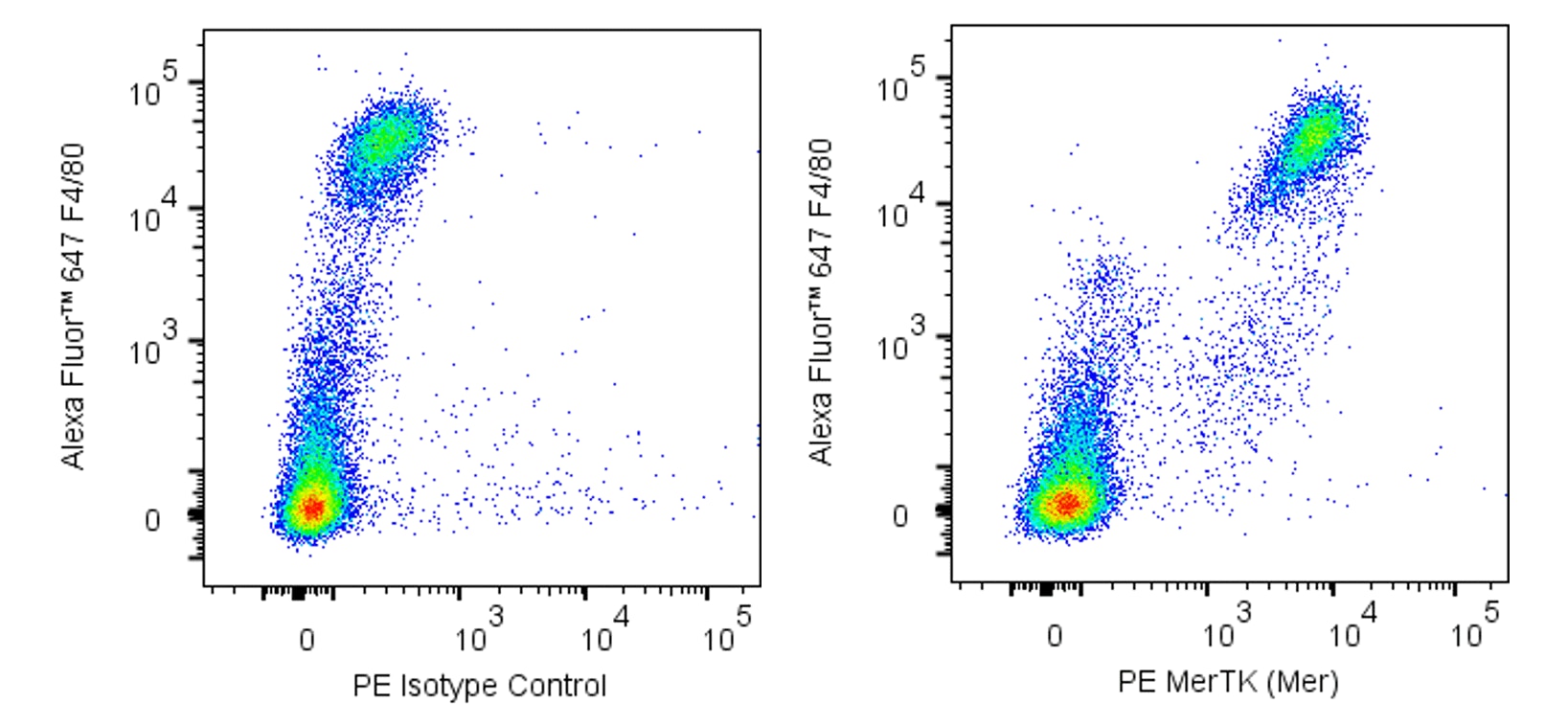
Two-color flow cytometric analysis of MerTK (Mer) expression on normal Mouse peritoneal cavity cells (PEC). PEC from C57BL/6 Mice were preincubated with Purified Rat Anti-Mouse CD16/CD32 antibody (Mouse BD Fc Block™) [Cat. No. 553142]. The cells were then stained with Alexa Fluor™ 647 Rat Anti-Mouse F4/80 antibody (Cat. No. 565853) and with either PE Rat IgG1, κ Isotype Control (Cat. No. 553925; Left Plot) or PE Rat Anti-Mouse MerTK (Mer) antibody (Cat. No. 570196/570197; Right Plot) at 0.25 µg/test. DAPI (4',6-Diamidino-2-Phenylindole, Dihydrochloride) Solution (Cat. No. 564907) was added to cells right before analysis. The bivariate pseudocolor density plot showing the expression of MerTK (Mer) [or Ig Isotype control staining] versus F4/80 was derived from gated events with the forward and side light-scatter characteristics of viable (DAPI-negative) PEC. Flow cytometry and data analysis were performed using a BD FACSCelesta™ Cell Analyzer System and FlowJo™ software. Data shown on this Technical Data Sheet are not lot specific.

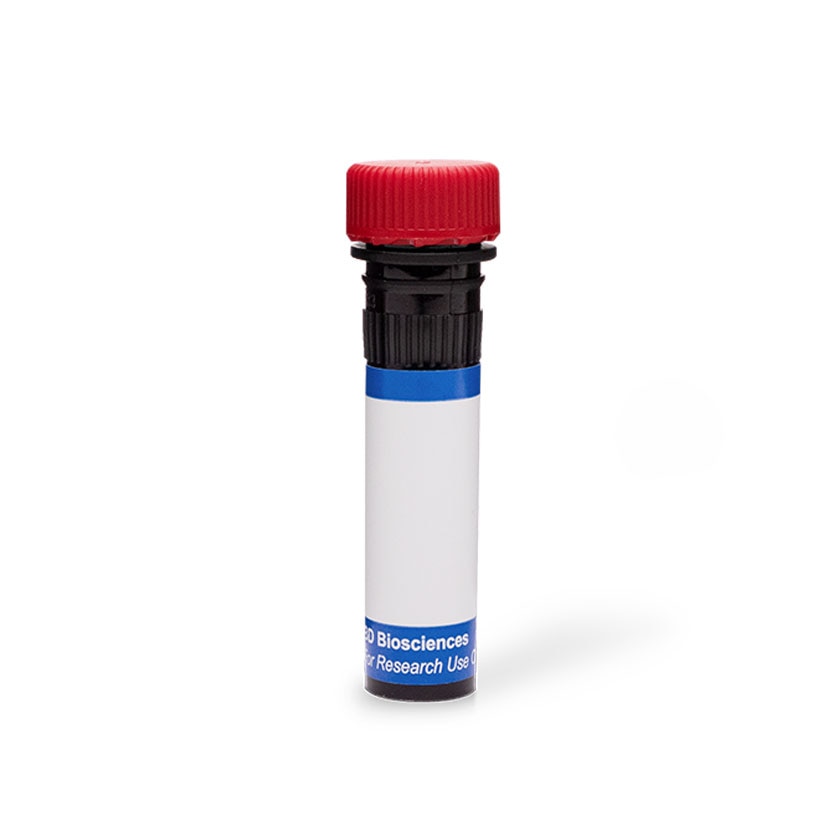
Two-color flow cytometric analysis of MerTK (Mer) expression on normal Mouse peritoneal cavity cells (PEC). PEC from C57BL/6 Mice were preincubated with Purified Rat Anti-Mouse CD16/CD32 antibody (Mouse BD Fc Block™) [Cat. No. 553142]. The cells were then stained with Alexa Fluor™ 647 Rat Anti-Mouse F4/80 antibody (Cat. No. 565853) and with either PE Rat IgG1, κ Isotype Control (Cat. No. 553925; Left Plot) or PE Rat Anti-Mouse MerTK (Mer) antibody (Cat. No. 570196/570197; Right Plot) at 0.25 µg/test. DAPI (4',6-Diamidino-2-Phenylindole, Dihydrochloride) Solution (Cat. No. 564907) was added to cells right before analysis. The bivariate pseudocolor density plot showing the expression of MerTK (Mer) [or Ig Isotype control staining] versus F4/80 was derived from gated events with the forward and side light-scatter characteristics of viable (DAPI-negative) PEC. Flow cytometry and data analysis were performed using a BD FACSCelesta™ Cell Analyzer System and FlowJo™ software. Data shown on this Technical Data Sheet are not lot specific.

Two-color flow cytometric analysis of MerTK (Mer) expression on normal Mouse peritoneal cavity cells (PEC). PEC from C57BL/6 Mice were preincubated with Purified Rat Anti-Mouse CD16/CD32 antibody (Mouse BD Fc Block™) [Cat. No. 553142]. The cells were then stained with Alexa Fluor™ 647 Rat Anti-Mouse F4/80 antibody (Cat. No. 565853) and with either PE Rat IgG1, κ Isotype Control (Cat. No. 553925; Left Plot) or PE Rat Anti-Mouse MerTK (Mer) antibody (Cat. No. 570196/570197; Right Plot) at 0.25 µg/test. DAPI (4',6-Diamidino-2-Phenylindole, Dihydrochloride) Solution (Cat. No. 564907) was added to cells right before analysis. The bivariate pseudocolor density plot showing the expression of MerTK (Mer) [or Ig Isotype control staining] versus F4/80 was derived from gated events with the forward and side light-scatter characteristics of viable (DAPI-negative) PEC. Flow cytometry and data analysis were performed using a BD FACSCelesta™ Cell Analyzer System and FlowJo™ software. Data shown on this Technical Data Sheet are not lot specific.


BD Pharmingen™ PE Rat Anti-Mouse MerTK (Mer)

Regulatory Statusの凡例
Any use of products other than the permitted use without the express written authorization of Becton, Dickinson and Company is strictly prohibited.
Preparation and Storage
推奨アッセイ手順
BD® CompBeads can be used as surrogates to assess fluorescence spillover (compensation). When fluorochrome conjugated antibodies are bound to BD® CompBeads, they have spectral properties very similar to cells. However, for some fluorochromes there can be small differences in spectral emissions compared to cells, resulting in spillover values that differ when compared to biological controls. It is strongly recommended that when using a reagent for the first time, users compare the spillover on cell and BD® CompBeads to ensure that BD® CompBeads are appropriate for your specific cellular application.
Product Notices
- Please refer to www.bdbiosciences.com/us/s/resources for technical protocols.
- Caution: Sodium azide yields highly toxic hydrazoic acid under acidic conditions. Dilute azide compounds in running water before discarding to avoid accumulation of potentially explosive deposits in plumbing.
- Since applications vary, each investigator should titrate the reagent to obtain optimal results.
- For fluorochrome spectra and suitable instrument settings, please refer to our Multicolor Flow Cytometry web page at www.bdbiosciences.com/colors.
- An isotype control should be used at the same concentration as the antibody of interest.
- Please refer to http://regdocs.bd.com to access safety data sheets (SDS).
- For U.S. patents that may apply, see bd.com/patents.
関連製品
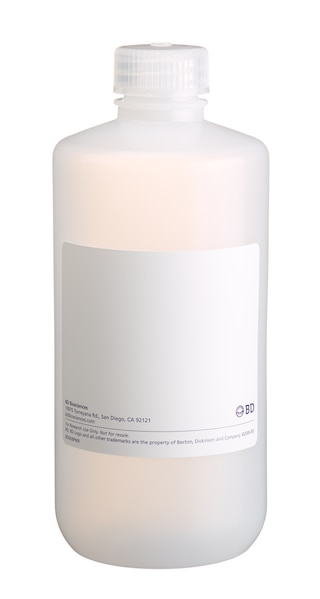
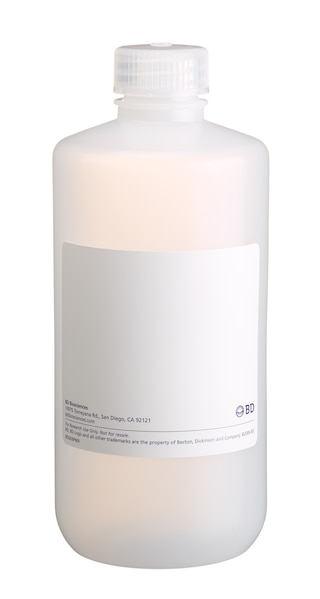
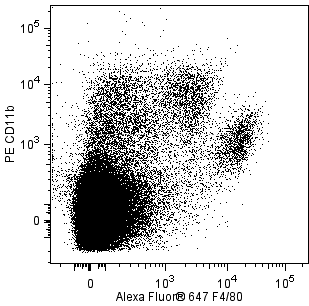

The BB14-16 monoclonal antibody specifically recognizes the Mer tyrosine kinase (MerTK). MerTK is a single-pass type I transmembrane glycoprotein that is encoded by Mertk (c-mer proto-oncogene tyrosine kinase) which is also known as Mer. MerTK (Mer) is comprised of an extracellular region with two immunoglobulin (Ig)-like domains and two fibronectin type III (FNIII) domains, a transmembrane segment, and a conserved intracellular tyrosine kinase domain. MerTK (Mer) belongs to the TAM subfamily of receptor tyrosine kinases (RTK) which includes Axl and Tyro-3. MerTK (Mer) is variably expressed by multiple cell types including monocytes, macrophages, dendritic cells, NK cells, platelets, and epithelial cells such as retinal pigment epithelial cells. Ligand binding leads to receptor dimerization, and autophosphorylation of tyrosine residues within the cytoplasmic MerTK (Mer) domain. This activates downstream signaling pathways that control cellular adhesion, aggregation, phagocytosis/efferocytosis, proliferation, survival, and migration. MerTK (Mer) ligands include Gas6 and Protein S that in turn may be bound to phosphatidylserine expressed on the outer plasma membrane of cells undergoing apoptosis. This promotes the phagocytosis of apoptotic cells. Through these activities, MerTK (Mer) plays major roles in the development and regulation of hematopoiesis and immunity. Abnormal cellular expression of MerTK (Mer) has been associated with some autoimmune diseases and various cancers.

Development References (3)
-
Dransfield I, Zagórska A, Lew ED, Michail K, Lemke G. Mer receptor tyrosine kinase mediates both tethering and phagocytosis of apoptotic cells.. Cell Death Dis. 2015; 6:e1646. (Biology). View Reference
-
Gould WR, Baxi SM, Schroeder R, et al. Gas6 receptors Axl, Sky and Mer enhance platelet activation and regulate thrombotic responses.. J Thromb Haemost. 2005; 3(4):733-41. (Biology). View Reference
-
Seitz HM, Camenisch TD, Lemke G, Earp HS, Matsushima GK. Macrophages and dendritic cells use different Axl/Mertk/Tyro3 receptors in clearance of apoptotic cells.. J Immunol. 2007; 178(9):5635-42. (Biology). View Reference
Please refer to Support Documents for Quality Certificates
Global - Refer to manufacturer's instructions for use and related User Manuals and Technical data sheets before using this products as described
Comparisons, where applicable, are made against older BD Technology, manual methods or are general performance claims. Comparisons are not made against non-BD technologies, unless otherwise noted.
For Research Use Only. Not for use in diagnostic or therapeutic procedures.